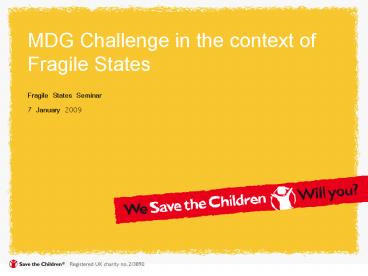MDG Challenge in the context of Fragile States - PowerPoint PPT Presentation
1 / 19
Title:
MDG Challenge in the context of Fragile States
Description:
Fragility defined as the lack of capacity or willingness to deliver core state ... (Somalia) and /or armed conflict (DRC), insecurity and political instability and ... – PowerPoint PPT presentation
Number of Views:66
Avg rating:3.0/5.0
Title: MDG Challenge in the context of Fragile States
1
MDG Challenge in the context of Fragile States
- Fragile States Seminar
- 7 January 2009
2
Contents
- Definition and links with MDGs
- FS Who are they?/Characteristics
- OECD DAC Engagement Principles
- What can we do Save UKs work
- Some current gaps and how these can be addressed
3
DFIDs view
- Fragility defined as the lack of capacity or
willingness to deliver core state functions for
the majority of people, including the poor,
thereby making it difficult to establish
effective aid partnerships states either
incapable and /or without political will
including extremely difficult situations of
complete state collapse (Somalia) and /or armed
conflict (DRC), insecurity and political
instability and state repression (Zimbabwe)
4
Link with MDGs
- The World Bank in its 2007 Global Monitoring
Report measuring progress on MDGs singled out
fragile states (along with gender equality) as
posing the greatest challenge for achieving MDG
targets.
5
MDGs at risk
6
Who are they?
- No agreed list, commonly used ones include Fund
for Peace, DFID, World Bank (LICUS), etc. - Save the Children generated list of
conflict-affected fragile states CAFS
(International Save the Children Alliance 2007)
total of 28 countries, issues of low income vs
lower middle income - The OECD DAC four-part typology arrested
development, deterioration, early recovery, post
conflict transition
7
Characteristics
- Characteristics of fragility
- Conflict
- Significant violation civil political rights
- Weak capacity of duty bearers
- Low or negative rates of economic growth
- Poor governance
- Lack of /collapse of basic services
8
OECD DAC
- 10 principles for engagement
- context,
- do no harm,
- focus on state building,
- prioritise prevention,
- links between political security and development
objectives, promote non-discrimination, - align with local priorities,
- coordination,
- stay engaged,
- avoid exclusion.
9
Save the Childrens current level of engagement
direct indirect
- Policy work on education, health
- Aid effectiveness
- Engagement in 2 networks (INEE Fragile States
health network) steering committee level - Treading a Delicate path
- Last in Line, Last in School education and
CAFS - Indirect Humanitarian Policy Unit Governance
work (Policy Learning) Use of Natural
Resources Public Expenditure - Upcoming role of private sector in FS
- Impact of economic growth on non-income poverty
10
Gaps
- Funding aversion
- Conflict mitigation prevention
- Livelihoods, social protection and Development
- Civil Society and Accountability
- Child Survival Inequity
11
Funding Aversion
- Receive 43 less aid than they should according
to population poverty etc - Donors still favour middle income that satisfy
donor criteria - Short term unpredictable aid
- Prioritisation of aid away from service delivery
(i.e. security sector reform)
12
Conflict Mitigation Prevention
- Important defining characteristic of Fragile
States - 90 of the LICUS countries have been in
conflict/currently in conflict - Current focus (DFID) is on assessment tools of
conflict fragility - Gap 1 Lack of focus on the role of sectoral
programs in the prevention/mitigation of conflict - Gap 2 Lack of focus on potential synergy between
peace building agents and sector program work
13
Livelihoods, social protection development
- Livelihoods promotion and social protection are
both approaches to reducing house hold poverty
one long term and the other more immediate - Employment generation for mothers and youth key
but need to understand context better - More analysis of role of private sector in this
regard - Social protection powerful short term
intervention tool challenge is to move towards
the setting up of longer term sustainable systems
owned by the state
14
Civil Society Accountability Mechanisms
- Compact between state and citizen, citizens
right to monitor the state (Ombudsman) - Gaps
- Organisational accountability often neglected
- Compact between state and citizen often weak in
fragile contexts focus often on accountability
of state to donor - Short route to long route how to move from
initial service delivery to state building
15
Child Survival Inequity
- There are more that 2,100 million children living
in the world today, nearly 320 million live in
fragile or conflict affected states. - The World Banks 2007 Global Monitoring Report
singled out fragile states as posing the greatest
challenge for achieving the MDG targets,
particularly MDG 4 and 5- child and maternal
survival. - Currently only two of the 35 states are on track
to meet MDG4 - Child mortality in fragile states over the past
15 years has remained higher and progressed more
slowly than in other low income countries. - Child survival indicators 51 of children dying
before the age of 5 - one-third of those under-nourished
- 44 of maternal deaths.
16
Child Survival and Inequity
17
Child Survival and Inequity
- Gap 1 Overall weak focus on child survival by
Government and donors beyond short term emergency
measures - Gap 2 Weak or non-existent health and nutrition
systems - Gap 3 Few national level strategies, policies or
institutional capacity to tackle child mortality - Gap 4 Poor political commitment and donor
aversion
18
Child Survival and Inequity
- Gap 5 Limited data, analysis and documentation
on child and maternal survival and the impact of
the burden of disease, death and equity on the
household and livelihoods in fragile states. - Gap 6 Limited analysis of the drivers of
inequity in the different typologies of fragile
states - Gap 7 Lack of focus on universal coverage to
effective child survival interventions
19
Nikhil RoyHead of Rights and Economic Justice































